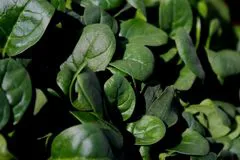 During minimally processing, fresh spinach is submitted to several mechanical operations such as cutting that may induce stress responses. These mechanical stresses may cause the accumulation of dangerous reactive oxygen species (ROS). Minimally processed vegetables respond to these mechanical stresses through different physiological mechanisms, among which the ascorbic acid (AsA) has a fundamental role.
During minimally processing, fresh spinach is submitted to several mechanical operations such as cutting that may induce stress responses. These mechanical stresses may cause the accumulation of dangerous reactive oxygen species (ROS). Minimally processed vegetables respond to these mechanical stresses through different physiological mechanisms, among which the ascorbic acid (AsA) has a fundamental role.Italian scientists at University of Milano and University of Foggia have studied the combined effects of cutting, storage temperature and duration on AsA oxidation and recycling. For the study, AsA gene expression and the enzymes involved in AsA oxidation and recycling were assessed.
Spinach leaves were cut into 6 pieces and stored at 4°C or 20°C for 6 days, intact leaves represented the control thesis. The enzymatic activity was analysed for all storage periods, while the gene expression was measured within 24hrs after cutting.
The results showed that after cutting AsA content decreased from 19.41 to 15mg/100g FW, and generally it was higher in samples stored at 4°C. After 6 days of storage, the AsA content was 10mg/100g FW in control samples and 5mg/100g FW in fresh-cut leaves.
Tab. - AsA content in control or cut leaves stored at 4°C (A) and 20°C (B). The first sampling (T0) refers to 1hr after cutting.
The gene expression and the activity of some enzymes involved in AsA oxidation and recycling resulted in accordance with AsA content levels. After cutting, the activity of ascorbate peroxidase (APX, EC 1.11.1.11) increased up to 290 nmol Asa/mg prot/min, while in the intact leaves APX was 190 nmol Asa/mg prot/min.
The scientists concluded that the AsA reduction is in primis due to improper storage temperature, then the AsA reduction increases with cutting procedures. Thus, the AsA content can be considered a fundamental postharvest quality indicator for fresh-cut spinach to evaluate leaf freshness
Source: Cocetta G., Baldassarre V., Spinardi A., Ferrante A., 'Effect of cutting on ascorbic acid oxidation and recycling in fresh-cut baby spinach (Spinacia oleracea L.) leaves', 2014, Postharvest Biology and Technology, Vol. 88, pagg. 8-16. Further info: www.sciencedirect.com/science/article/pii/S0925521413002767
